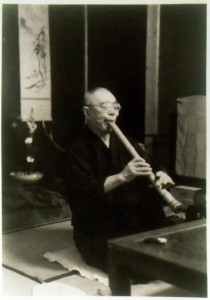Justin the good fortune to study 12 honkyoku from the lineage of Jin Nyodō with Kurahashi Yoshio in Kyōtō, and 16 honkyoku from Jin Nyodō’s top student, Satō Jōkan in Kyūshū.
Jin Nyodō came from Tsugaru in Northern Japan, the home of the Kimpū-ryū (also known as Nezasa-ha) school of shakuhachi, and, of the honkyoku it is this repertoire which he is most noted for. He later moved to Tokyo where he studied Kinko-ryū sankyoku (ensemble music), memorizing and notating many pieces, and performing extensively.
Jin’s interest in honkyoku led him to travel across Japan, collecting together a repertoire of about 50 pieces, researching and writing about the musical structure of the honkyoku and the differences between styles. He was noted by his contemporaries for his unique performance style of the pieces he played, creating his own arrangements of the honkyoku he had learned, and even composing 2 new pieces of his own. He was keen to explore as a creative artist, gaining inspiration from visiting sites connected to the various honkyoku, or rearranging pieces to give a mood he felt more suitable. This was uncommon at the time, as it is traditional in Japan to play as closely as possible to your teacher, and to not deliberately rearrange or change the pieces. Jin may have felt more free in this manner since studied not with one but with many teachers, and so did not “belong” as such to the schools whose honkyoku he arranged. However for the honkyoku of his home and upbringing, Nezasa-ha, he played in a very traditional manner.
Jin had notable effect not only on his own students but also two new schools of his time, Ueda-ryū and Chikuho-ryū, both of which adopted a number of his honkyoku.

